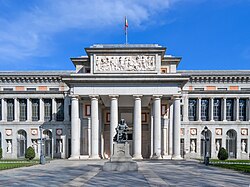 | |
 Front façade (Velázquez entrance) in 2016 | |
 | |
| Established | 19 November 1819 |
|---|---|
| Location | Paseo del Prado, Madrid, Spain |
| Type | Art museum, historic site |
| Visitors | 3,337,550 (2023)[1] Ranked 13th globally (2023)[2] |
| Director | Miguel Falomir[3] |
| Public transit access | |
| Website | museodelprado.es |
| Architect | Juan de Villanueva |
| Official name | Museo Nacional del Prado |
| Type | Non-movable |
| Criteria | Monument |
| Designated | 1962 |
| Reference no. | RI-51-0001374 |
The Museo del Prado (/ˈprɑːdoʊ/ PRAH-doh; Spanish pronunciation: [muˈseo ðel ˈpɾaðo]), officially known as Museo Nacional del Prado, is the main Spanish national art museum, located in central Madrid. It houses collections of European art, dating from the 12th century to the early 20th century, based on the former Spanish royal collection, and the single best collection of Spanish art. Founded as a museum of paintings and sculpture in 1819, it also contains important collections of other types of works. The numerous works by Francisco Goya, the single most extensively represented artist, as well as by Hieronymus Bosch, El Greco, Peter Paul Rubens, Titian, and Diego Velázquez, are some of the highlights of the collection. Velázquez and his keen eye and sensibility were also responsible for bringing much of the museum's fine collection of Italian masters to Spain, now one of the largest outside of Italy.
The collection currently comprises around 8,200 drawings, 7,600 paintings, 4,800 prints, and 1,000 sculptures, in addition to many other works of art and historic documents. As of 2012, the museum displayed about 1,300 works in the main buildings, while around 3,100 works were on temporary loan to various museums and official institutions. The remainder were in storage.[4]
Due to the COVID-19 pandemic, in 2020 attendance plunged by 76 percent to 852,161. Nonetheless, the Prado was ranked as the 16th most-visited museum in the list of most-visited art museums in the world in 2020.[5] It is one of the largest museums in Spain.
The Prado, with the nearby Thyssen-Bornemisza Museum and the Museo Reina Sofía, forms Madrid's Golden Triangle of Art, which was included in the UNESCO World Heritage list in 2021.
- ^ "El Museo Nacional del Prado ha recibido 3.337.550 visitas en 2023". museodelprado.es. Museo Del Prado. Retrieved 2 September 2024.
- ^ Cheshire, Lee; da Silva, José (27 March 2023). "The 100 most popular art museums in the world—who has recovered and who is still struggling?". The Art Newspaper. Archived from the original on 28 March 2023. Retrieved 8 July 2023.
- ^ Barrigós, Concha (21 March 2017). "Miguel Falomir, nuevo director del Prado: "Nunca, nunca pediré el traslado del 'Guernica'"". 20 minutos. Retrieved 1 April 2017.
- ^ "The Collection: origins". Museo Nacional del Prado. Retrieved 15 November 2012.See also Museo del Prado, Catálogo de las pinturas, 1996, Ministerio de Educación y Cultura, Madrid, No ISBN, which lists about 7,800 paintings. Many works have been passed to the Museo Reina Sofia and other museums over the years; others are on loan or in storage. On the new displays, see El Prado se reordena y agranda. europapress.es here (in Spanish)
- ^ "The Art Newspaper", 31 March 2021